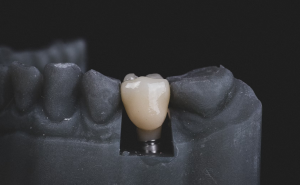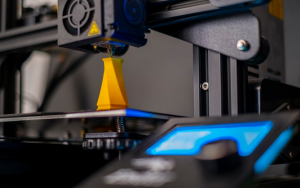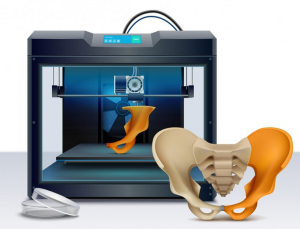The advent of 3D printing in the medical sphere has been nothing short of revolutionary, ushering in an era where the creation of custom-designed prosthetics and implants is becoming the norm rather than the exception. This technology is carving out a niche in healthcare, offering levels of personalization previously thought impossible. We will dive deep into how 3D printing is changing the face of medicine, bringing cutting-edge treatments from the realm of science fiction into our day-to-day lives.
Shaping prosthetics and crafting intricate implants with 3D printing has dramatically affected how patients receive care. Let’s reveal the intricate history of this technology, examine its present impact on medical care, and predict how it might continue to evolve and reshape patient remedies in the years to come.

History of 3D Printing in Medical Applications
Contents
Dating back a few decades, 3D printing made its humble debut in the medical world through dental implants. This marked the beginning of a journey toward a future where precisely customized medical devices have become key to advanced patient care. Embracing 3D printing has enabled the medical industry to create prosthetics and other devices that are tailored to fit patient specifics quickly and cost-effectively, unlike traditional cumbersome and costlier approaches.
This shift to 3D printing signaled a major leap forward from the ‘one-size-fits-all’ approach, heralding a new age in bespoke medical device manufacturing. Devices could be created on-demand, slashing costs and lead times. It’s not an understatement to say that 3D printing is galvanizing not just the way prosthetics are made but also how they are imagined, setting new benchmarks in healthcare worldwide.

3D Printing technologies used in prosthetics
The transformation in prosthetics production due to 3D printing is astounding. Through methods such as SLA and SLS, prosthetics are now being made to be as form-fitting and comfortable as they are functional. This tech enables the design of prosthetics with specific internal structures, achieving an optimal balance between strength and weight which wasn’t possible with older methods.
It’s this blend of cutting-edge technology and patient-centered design that makes 3D-printed prosthetics not just a medical device but a way to restore personal freedom. Profound success stories, such as patients receiving highly specialized 3D-printed body parts, showcase the impactful reality of this technology that transcends traditional methods, delivering hope and the promise of improved quality of life.
The impact of 3D Printing on implants
The realm of implants has been equally transformed by the touch of 3D printing. A game-changer for surgeons, this technology allows for implants to be custom-fitted to the minutest details of a patient’s anatomy, resulting in enhanced integration and function. This degree of precision confers a wealth of benefits, not least of which includes quicker recoveries and less invasiveness during surgeries.
Patients treated with 3D-printed implants are experiencing improved surgical outcomes and shorter recuperation times. Meanwhile, regulatory bodies are proactive in establishing guidelines to maintain the safety and efficacy standards for these cutting-edge devices, thereby safeguarding patient well-being as the technology continues to advance.

Customization and Personalization
In the pulse of 3D printing in medicine, we find a relentless pursuit of customization. Mimicking the body’s complexities perfectly, 3D printing allows for implants and devices that align impeccably with individual patients, leading to better-fit and higher performance. This high degree of tailoring not only leads to better physical outcomes but also boosts patients’ morale by providing devices that align aesthetically with their self-image.
The rise of bespoke 3D models in surgical planning exemplifies how personalized medicine is becoming the gold standard for care. These models enable surgeons to approach procedures with greater confidence and precision, ultimately leading to successful outcomes and a faster return to normalcy for patients. Indeed, the patient-centered edge that 3D printing offers heralds a transformative shift in how medical care is conceived and delivered.
Advancements and future of medical 3D Printing
With each stride in the field of 3D printing, the boundaries between fiction and reality blur further. Today, cutting-edge research in bioprinting tissues and the development of new, bodily compatible materials showcase a future brimming with medical possibilities. The forecast in 3D printing spells out a tapestry of richer customization, blended seamlessly with smart medical technologies.
Look to the horizon, and you’ll see a future where prosthetics not only replicate human anatomy but intuitively respond to their user’s needs. The possibility of drug-delivering implants further highlights the therapeutic potential of 3D printing in crafting targeted, efficient treatments. Research in this field isn’t just patching up current healthcare challenges; it’s boldly chartering new territories in the medical frontier.

Challenges and limitations
Navigating the promising waves of 3D printing in healthcare does bring its share of challenges and concerns. From the technical aspects of material compatibility to dipping one’s toes into the ethical quandaries of bioprinting and genetic material, 3D printing’s advance isn’t issue-free. Cost and infrastructure requirements put this revolutionary healthcare at arm’s length for many, spotlighting the need for equitable solutions to make the technology more universally accessible.

Standing at the forefront of technological integration in healthcare, 3D printing is reshaping the medical landscape, particularly within prosthetics and implants. It’s fostering a new era of precision medicine, aiding in better patient outcomes, and constantly evolving to bring future medical wonders into today’s clinics and operating rooms.
As this technology matures, it will require an orchestra of cooperation across various sectors to fully realize its potential and democratize its access. In its essence, 3D printing in medicine carries the promise of a more humane approach to healthcare, where innovation goes hand in hand with improved human wellbeing.

